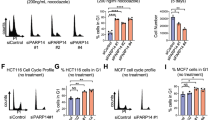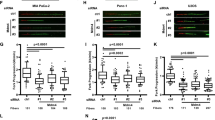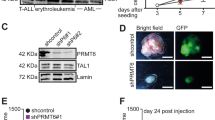Abstract
The p16INK4a protein regulates cell cycle progression mainly by inhibiting the activity of G1-phase cyclin-dependent kinases (CDKs) 4 and 6, the subsequent retinoblastoma protein (pRb) phosphorylation and E2F transcription factor release. The p16INK4a protein can also repress the activity of other transcription factors, such as c-myc, nuclear factor-kappaB and c-Jun/AP1. Here, we report that, in two p16−/−, pRbWT and p53WT cell lines (MCF7 and U87), p16INK4a overexpression induces a dramatic decrease in CDK1 protein expression. In response to p16INK4a, the decreased rate of CDK1 protein synthesis, its unchanged protein half-life, unreduced CDK1 mRNA steady-state levels and mRNA half-life allow us to hypothesize that p16INK4a could regulate CDK1 expression at the post-transcriptional level. This CDK1 downregulation is mediated by the 3′-untranslated region (3′UTR) of CDK1 mRNA as shown by translational inhibition in luciferase assays and is associated with a modified expression balance of microRNAs (miRNAs) that potentially regulate CDK1, analyzed by TaqMan Human microRNA Array. The p16INK4a-induced expression of two miRNAs (miR-410 and miR-650 chosen as an example) in MCF7 cells is confirmed by individual reverse transcription–qPCR. Furthermore, we show the interaction of miR-410 or miR-650 with CDK1-3′UTR by luciferase assays. Endogenous CDK1 expression decreases upon both miRNA overexpression and increases with their simultaneous inhibition. The induction of miR-410, but not miR-650 could be related to the pRb/E2F pathway. These results demonstrate the post-transcriptional inhibition of CDK1 by p16INK4a. We suggest that p16INK4a may regulate gene expression by modifying the functional equilibrium of transcription factors and consequently the expression balance of miRNAs.
This is a preview of subscription content, access via your institution
Access options
Subscribe to this journal
Receive 50 print issues and online access
$259.00 per year
only $5.18 per issue
Buy this article
- Purchase on Springer Link
- Instant access to full article PDF
Prices may be subject to local taxes which are calculated during checkout






Similar content being viewed by others
References
Alevizopoulos K, Vlach J, Hennecke S, Amati B . (1997). Cyclin E and c-Myc promote cell proliferation in the presence of p16INK4a and of hypophosphorylated retinoblastoma family proteins. Embo J 16: 5322–5333.
Baghdassarian N, Catallo R, Mahly MA, Ffrench P, Chizat F, Bryon PA et al. (1998). Glucocorticoids induce G1 as well as S-phase lengthening in normal human stimulated lymphocytes: differential effects on cell cycle regulatory proteins. Exp Cell Res 240: 263–273.
Baghdassarian N, Peiretti A, Devaux E, Bryon PA, Ffrench M . (1999). Involvement of p27Kip1 in the G1- and S/G2-phase lengthening mediated by glucocorticoids in normal human lymphocytes. Cell Growth Differ 10: 405–412.
Berthet C, Aleem E, Coppola V, Tessarollo L, Kaldis P . (2003). Cdk2 knockout mice are viable. Curr Biol 13: 1775–1785.
Cairns P, Polascik TJ, Eby Y, Tokino K, Califano J, Merlo A et al. (1995). Frequency of homozygous deletion at p16/CDKN2 in primary human tumours. Nat Genet 11: 210–212.
Calbo J, Serna C, Garriga J, Grana X, Mazo A . (2004). The fate of pancreatic tumor cell lines following p16 overexpression depends on the modulation of CDK2 activity. Cell Death Differ 11: 1055–1065.
Chen RW, Bemis LT, Amato CM, Myint H, Tran H, Birks DK et al. (2008). Truncation in CCND1 mRNA alters miR-16-1 regulation in mantle cell lymphoma. Blood 112: 822–829.
Chien WW, Domenech C, Catallo R, Salles G, Ffrench M . (2010). S-phase lengthening induced by p16(INK4a) overexpression in malignant cells with wild-type pRb and p53. Cell Cycle 9: 3286–3296.
Choi BY, Choi HS, Ko K, Cho YY, Zhu F, Kang BS et al. (2005). The tumor suppressor p16(INK4a) prevents cell transformation through inhibition of c-Jun phosphorylation and AP-1 activity. Nat Struct Mol Biol 12: 699–707.
Cox CV, Martin HM, Kearns PR, Virgo P, Evely RS, Blair A . (2007). Characterization of a progenitor cell population in childhood T-cell acute lymphoblastic leukemia. Blood 109: 674–682.
Eiring AM, Harb JG, Neviani P, Garton C, Oaks JJ, Spizzo R et al. (2010). miR-328 functions as an RNA decoy to modulate hnRNP E2 regulation of mRNA translation in leukemic blasts. Cell 140: 652–665.
Farh KK, Grimson A, Jan C, Lewis BP, Johnston WK, Lim LP et al. (2005). The widespread impact of mammalian MicroRNAs on mRNA repression and evolution. Science 310: 1817–1821.
Haas K, Staller P, Geisen C, Bartek J, Eilers M, Moroy T . (1997). Mutual requirement of CDK4 and Myc in malignant transformation: evidence for cyclin D1/CDK4 and p16INK4A as upstream regulators of Myc. Oncogene 15: 179–192.
Hara E, Smith R, Parry D, Tahara H, Stone S, Peters G . (1996). Regulation of p16CDKN2 expression and its implications for cell immortalization and senescence. Mol Cell Biol 16: 859–867.
Harada H, Nakagawa K, Iwata S, Saito M, Kumon Y, Sakaki S et al. (1999). Restoration of wild-type p16 down-regulates vascular endothelial growth factor expression and inhibits angiogenesis in human gliomas. Cancer Res 59: 3783–3789.
He L, He X, Lim LP, de Stanchina E, Xuan Z, Liang Y et al. (2007). A microRNA component of the p53 tumour suppressor network. Nature 447: 1130–1134.
Hutvagner G, Zamore PD . (2002). A microRNA in a multiple-turnover RNAi enzyme complex. Science 297: 2056–2060.
Kaddar T, Rouault JP, Chien WW, Chebel A, Gadoux M, Salles G et al. (2009). Two new miR-16 targets: caprin-1 and HMGA1, proteins implicated in cell proliferation. Biol Cell 101: 511–524.
Kamb A, Shattuck-Eidens D, Eeles R, Liu Q, Gruis NA, Ding W et al. (1994). Analysis of the p16 gene (CDKN2) as a candidate for the chromosome 9p melanoma susceptibility locus. Nat Genet, Vol 8: pp 23–26.
Kataoka M, Wiehle S, Spitz F, Schumacher G, Roth JA, Cristiano RJ . (2000). Down-regulation of bcl-2 is associated with p16INK4-mediated apoptosis in non-small cell lung cancer cells. Oncogene 19: 1589–1595.
Katsuda K, Kataoka M, Uno F, Murakami T, Kondo T, Roth JA et al. (2002). Activation of caspase-3 and cleavage of Rb are associated with p16-mediated apoptosis in human non-small cell lung cancer cells. Oncogene 21: 2108–2113.
Kopper L, Hajdu M . (2004). Tumor stem cells. Pathol Oncol Res 10: 69–73.
Kozar K, Ciemerych MA, Rebel VI, Shigematsu H, Zagozdzon A, Sicinska E et al. (2004). Mouse development and cell proliferation in the absence of D-cyclins. Cell 118: 477–491.
Lagos-Quintana M, Rauhut R, Lendeckel W, Tuschl T . (2001). Identification of novel genes coding for small expressed RNAs. Science 294: 853–858.
Leclerc GJ, Leclerc GM, Barredo JC . (2002). Real-time RT-PCR analysis of mRNA decay: half-life of Beta-actin mRNA in human leukemia CCRF-CEM and Nalm-6 cell lines. Cancer Cell Int 2: 1.
Liu J, Valencia-Sanchez MA, Hannon GJ, Parker R . (2005). MicroRNA-dependent localization of targeted mRNAs to mammalian P-bodies. Nat Cell Biol 7: 719–723.
Lytle JR, Yario TA, Steitz JA . (2007). Target mRNAs are repressed as efficiently by microRNA-binding sites in the 5′ UTR as in the 3′ UTR. Proc Natl Acad Sci USA 104: 9667–9672.
Malumbres M, Sotillo R, Santamaria D, Galan J, Cerezo A, Ortega S et al. (2004). Mammalian cells cycle without the D-type cyclin-dependent kinases Cdk4 and Cdk6. Cell 118: 493–504.
Molofsky AV, Pardal R, Iwashita T, Park IK, Clarke MF, Morrison SJ . (2003). Bmi-1 dependence distinguishes neural stem cell self-renewal from progenitor proliferation. Nature 425: 962–967.
Molofsky AV, Slutsky SG, Joseph NM, He S, Pardal R, Krishnamurthy J et al. (2006). Increasing p16INK4a expression decreases forebrain progenitors and neurogenesis during ageing. Nature 443: 448–452.
Moser JJ, Eystathioy T, Chan EK, Fritzler MJ . (2007). Markers of mRNA stabilization and degradation, and RNAi within astrocytoma GW bodies. J Neurosci Res 85: 3619–3631.
Nalabothula N, Lakka SS, Dinh DH, Gujrati M, Olivero WC, Rao JS . (2007). Sense p16 and antisense uPAR bicistronic construct inhibits angiogenesis and induces glioma cell death. Int J Oncol 30: 669–678.
Nishiwaki E, Turner SL, Harju S, Miyazaki S, Kashiwagi M, Koh J et al. (2000). Regulation of CDK7-carboxyl-terminal domain kinase activity by the tumor suppressor p16(INK4A) contributes to cell cycle regulation. Mol Cell Biol 20: 7726–7734.
O'Donnell KA, Wentzel EA, Zeller KI, Dang CV, Mendell JT . (2005). c-Myc-regulated microRNAs modulate E2F1 expression. Nature 435: 839–843.
Pillai RS, Bhattacharyya SN, Filipowicz W . (2007). Repression of protein synthesis by miRNAs: how many mechanisms? Trends Cell Biol 17: 118–126.
Raver-Shapira N, Marciano E, Meiri E, Spector Y, Rosenfeld N, Moskovits N et al. (2007). Transcriptional activation of miR-34a contributes to p53-mediated apoptosis. Mol Cell 26: 731–743.
Rodriguez A, Griffiths-Jones S, Ashurst JL, Bradley A . (2004). Identification of mammalian microRNA host genes and transcription units. Genome Res 14: 1902–1910.
Saetrom P, Heale BS, Snove Jr O, Aagaard L, Alluin J, Rossi JJ . (2007). Distance constraints between microRNA target sites dictate efficacy and cooperativity. Nucleic Acids Res 35: 2333–2342.
Santamaria D, Barriere C, Cerqueira A, Hunt S, Tardy C, Newton K et al. (2007). Cdk1 is sufficient to drive the mammalian cell cycle. Nature 448: 811–815.
Serrano M, Gomez-Lahoz E, DePinho RA, Beach D, Bar-Sagi D . (1995). Inhibition of ras-induced proliferation and cellular transformation by p16INK4. Science 267: 249–252.
Serrano M, Hannon GJ, Beach D . (1993). A new regulatory motif in cell-cycle control causing specific inhibition of cyclin D/CDK4. Nature 366: 704–707.
Serrano M, Lee H, Chin L, Cordon-Cardo C, Beach D, DePinho RA . (1996). Role of the INK4a locus in tumor suppression and cell mortality. Cell 85: 27–37.
Shapiro GI, Edwards CD, Ewen ME, Rollins BJ . (1998). p16INK4A participates in a G1 arrest checkpoint in response to DNA damage. Mol Cell Biol 18: 378–387.
Souza-Rodrigues E, Estanyol JM, Friedrich-Heineken E, Olmedo E, Vera J, Canela N et al. (2007). Proteomic analysis of p16ink4a-binding proteins. Proteomics 7: 4102–4111.
Urashima M, DeCaprio JA, Chauhan D, Teoh G, Ogata A, Treon SP et al. (1997). p16INK4A promotes differentiation and inhibits apoptosis of JKB acute lymphoblastic leukemia cells. Blood 90: 4106–4115.
Vasudevan S, Tong Y, Steitz JA . (2007). Switching from repression to activation: microRNAs can up-regulate translation. Science 318: 1931–1934.
Wang B, David MD, Schrader JW . (2005). Absence of caprin-1 results in defects in cellular proliferation. J Immunol 175: 4274–4282.
Wolff B, Naumann M . (1999). INK4 cell cycle inhibitors direct transcriptional inactivation of NF-kappaB. Oncogene 18: 2663–2666.
Woods K, Thomson JM, Hammond SM . (2007). Direct regulation of an oncogenic micro-RNA cluster by E2F transcription factors. J Biol Chem 282: 2130–2134.
Yin Q, Wang X, McBride J, Fewell C, Flemington E . (2008). B-cell receptor activation induces BIC/miR-155 expression through a conserved AP-1 element. J Biol Chem 283: 2654–2662.
Zhu W, Giangrande PH, Nevins JR . (2004). E2Fs link the control of G1/S and G2/M transcription. Embo J 23: 4615–4626.
Zwicker J, Lucibello FC, Wolfraim LA, Gross C, Truss M, Engeland K et al. (1995). Cell cycle regulation of the cyclin A, cdc25C and cdc2 genes is based on a common mechanism of transcriptional repression. Embo J 14: 4514–4522.
Acknowledgements
This work was supported by the Ligue contre le Cancer of Saône-et-Loire and Rhône, by the Fondation pour la Recherche Médicale and by the Cancéropole Lyon-Auvergne-Rhône-Alpes.
Author information
Authors and Affiliations
Corresponding author
Ethics declarations
Competing interests
The authors declare no conflict of interest.
Additional information
Supplementary Information accompanies the paper on the Oncogene website
Supplementary information
Rights and permissions
About this article
Cite this article
Chien, W., Domenech, C., Catallo, R. et al. Cyclin-dependent kinase 1 expression is inhibited by p16INK4a at the post-transcriptional level through the microRNA pathway. Oncogene 30, 1880–1891 (2011). https://doi.org/10.1038/onc.2010.570
Received:
Revised:
Accepted:
Published:
Issue Date:
DOI: https://doi.org/10.1038/onc.2010.570
Keywords
This article is cited by
-
MicroRNA-650 Regulates the Pathogenesis of Alzheimer’s Disease Through Targeting Cyclin-Dependent Kinase 5
Molecular Neurobiology (2023)
-
CDKN2A, CDK1, and CCNE1 overexpression in sebaceous gland carcinoma of eyelid
International Ophthalmology (2020)
-
miR-410-3p Suppresses Cytokine Release from Fibroblast-Like Synoviocytes by Regulating NF-κB Signaling in Rheumatoid Arthritis
Inflammation (2019)
-
miR-650 promotes motility of anaplastic thyroid cancer cells by targeting PPP2CA
Endocrine (2019)
-
Lineage-dependent role of miR-410-3p as oncomiR in gonadotroph and corticotroph pituitary adenomas or tumor suppressor miR in somatotroph adenomas via MAPK, PTEN/AKT, and STAT3 signaling pathways
Endocrine (2019)



